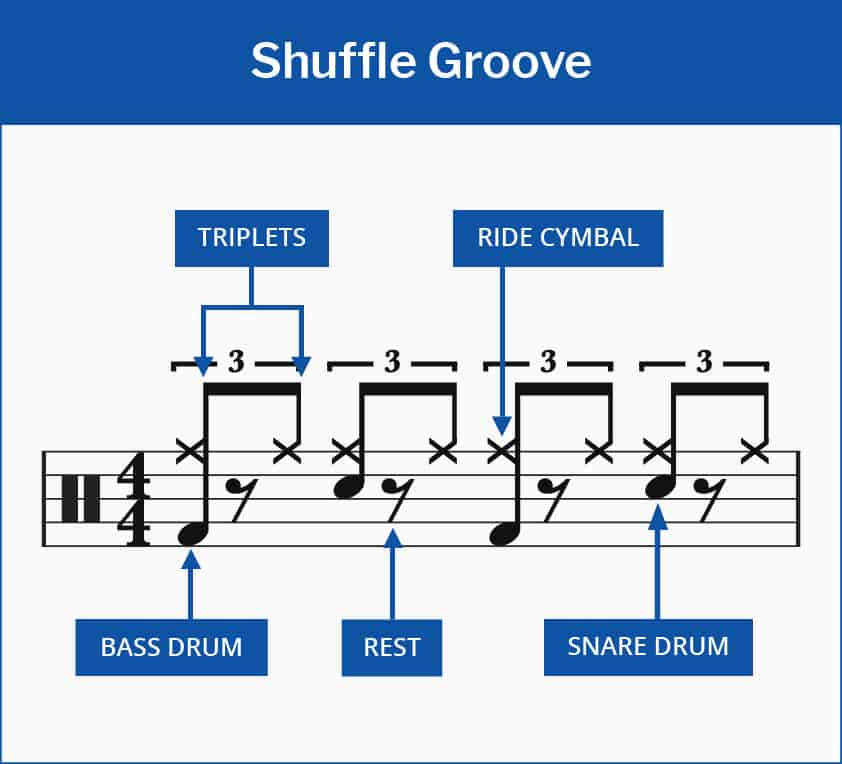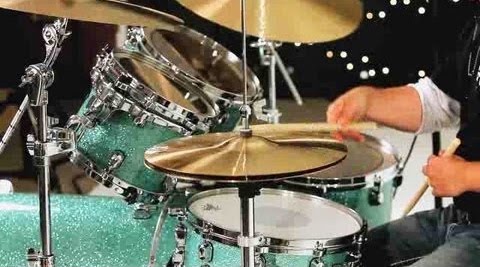It’s the question that every beginner drummer wants to know the answer to: what drum beats should I learn? Which common drum beats will allow me to jam my favourite songs like a pro?
Whether you dream of rocking a stadium or simply want to start a local band, it all starts with these standard drum beats.
As a professional drummer, I’ve picked the 10 examples that I use most often in my work.
We’ll start by looking at the most common backbeats (where the snare drum is played on beats 2 and 4).
Then, we’ll explore some of the more complex backbeats and drum grooves out there, adding more variety and difficulty as we go along.
And stay tuned, because I’ll be showing you at the end of this article exactly how to learn these drum beats for yourself.
If you can get a grip on these ten drum beats, you’ll be well on your way to becoming a capable and versatile player.
Whatever genres of music you love, there’ll likely be a beat to suit you in this wide-ranging guide.
We’ll be looking at everything from hip-hop to the blues, jazz to metal, and everything in between.
So without further ado, let’s get started!
Top 10 common drum beats
- Standard 8th note groove
- Four to the floor
- Shuffle groove
- 16th note groove
- 12/8 groove
- Motown groove
- Reggae groove
- Disco groove
- Jazz ostinato
- Half-time shuffle
See any drum beats that catch your eye immediately? Jump straight to your favourite groove with the links above.
Otherwise, let’s start from the beginning.
What better place to start than with the most popular drum beat of all time?
Standard 8th note groove
No drum beat is more iconic than the standard 8th note groove.
In fact, it provides the foundation for most of the music that we listen to.
You’ll have heard it countless times in pop, rock, blues, metal and a variety of other musical styles.
I’d be willing to place a bet with you that this beat appears more in your playlist than any other.
To get us started, let’s have a listen to what it sounds like:
If you’re reading this on mobile, choose the ‘listen in browser’ option when listening to the beats to make it easier to follow along with the article.
Then, take a look at the infographic below that breaks down how this drum beat works.

In a standard bar of music, we have 4 beats. That’s why our first job as drummers is to count to 4 to bring the band in at the start of a song.
On beats 1 and 3, you play the low-pitched bass drum. On beats 2 and 4, you play the high-pitched snare drum.
Keeping great time is your most important job as a drummer, and the bass and snare are the key weapons that will make you into a first-class timekeeper.
Great drummers move from bass to snare in the same way that a pendulum moves from side to side.
This creates a feeling of motion that encourages listeners to dance, rock out, and get lost in the music!
Don’t forget the hi-hats
The final part of this groove is the 8th notes which drummers typically play on the hi-hat cymbal.
You can think of these 8th notes as the essential glue that holds the groove together.
Drummers play the hi-hat on all 4 beats as well as the spaces in-between.
So how does that work?
If you were to count the hi-hats out loud, you would count them as “1 and 2 and 3 and 4 and”. This gives you 8 notes in total, hence why this known as the standard 8th note groove.
If this all sounds a bit confusing, don’t panic. You don’t have to be a rocket scientist to learn to play the drums, you just have to take it step by step.
If you’re feeling so comfortable so far, let’s get on with the next groove and hear our next musical examples.
Four to the floor
The four to the floor drum beat adds an extra level of funkiness to the standard 8th note groove.
Rather than just playing the bass drum on beats 1 and 3, the bass drum is now played on all 4 beats.
It’s THE groove you should learn if you want to get into pop, funk and disco drumming.
One essential track that you must listen to if you want to hear a great example of a four to the floor beat is Stevie Wonder’s ‘Superstition’.
Hear how the drummer plays a bass drum on every beat and adds extra variety by improvising on the hi-hat cymbal.
The constant pulse creates a rock-solid feeling to the music, which is exactly what we want to create as drummers!
In fact, working on your timing is the most essential element of becoming a great drummer.
Shuffle groove
The shuffle groove is one of my personal favourites and one I’m sure you’ll be familiar with.
This drum beat keeps the same bass and snare rhythm as the previous grooves but uses a unique and quite brilliant cymbal pattern.
This cymbal pattern uses a triplet rhythm to create a bouncing feeling known as a shuffle.
How does it do that?
A triplet is made up of 3 notes, but in this track, it plays only 2 of the 3 notes.
Here’s how it looks in sheet music.

Can you see how the two triplet notes that are played are close together, and then there is a space in the middle between them?
This busyness, followed by space, followed by busyness, creates a bounciness to the rhythm.
Here’s a real-life example for you.
Have a listen to Stevie Ray Vaughan’s famous blues track ‘Pride and Joy’. Can you hear the bounce in the cymbal rhythm?
Learning the shuffle is one of the key items in your drumming toolbox. Many of the legendary drummers of the past are famous for their shuffles.
In fact, we’ll cover some famous and super complicated shuffles later.
16th note groove
If you’re a fan of hip-hop, R&B or classic rock, then you’ll love the next drum beat on our list.
The 16th note groove is our busiest drum pattern yet, with four hi-hats played for every bass and snare beat.
These 16th notes are also known as semiquavers and are considerably harder to play than 8th notes.
But don’t hang up your sticks just yet. You’ve got this!
To inspire you, check out this great example of a 16th note groove.
Find out why drummers have voted it one of the top drumming tracks of all time!
Developing the 16th note groove beat skills
To play this beat, you’ll have to build up your muscle memory and stamina.
Drummers often do this with a practice pad, which allows you to practise the fundamentals of drumming without a drum kit.
I practice on a pad whenever I’m not near a drum kit and this has helped me develop the technical ability to play some of my favourite grooves.
Also, check out the picture of Rush drummer Neil Peart’s drum kit below.

You know you’ve made it as a drummer when your drum kit completely surrounds you!
I do feel a little sorry for his roadie though.
12/8 groove
While drum beats are often the loudest and most obvious element of a track, the truly great drummers are able to play with incredible subtlety and control.
One beat for which it is particularly important to play dynamically (that is, the ability to play soft as well as loud) is the 12/8 groove.
This groove is a classic accompaniment to ballads, slow rock tracks and blues tunes.
In these tracks, the drummer gently keeps time, providing space for deeply moving vocal and guitar performances.
For this groove, the drummer plays 3 hi-hats for every bass and snare beat.
In effect, there are 12 8th notes, which gives the groove its name.
One artist famous for using 12/8 grooves in his songs is Gary Moore, a personal favourite of professional guitarists.
DID YOU KNOW? Drummers sometimes use wire brushes to play songs that are too delicate for drumsticks.
Motown drum beat groove
Motown is an iconic record label that produced much of the chart-topping music of the 1960s onwards.
If you are a fan of Stevie Wonder, the Supremes, Marvin Gaye or the Jackson Five, you’ll be listening to sound of Motown.
One great drum beat that came out of the so-called Motown “hit-factory” was a beat that completely reinvented the standard 8th note groove.
Rather than playing the snare on just the 2 and 4, the standard Motown groove adds a snare to every single beat.
This provides a driving rhythm that pushes a song forwards with a bouncy, upbeat feel.
Check out legendary Motown drummer James Gadson demonstrating the standard Motown groove in the video below.
Reggae groove
If you’ve got this far through our exploration of our top 10 popular drum beats, you might be feeling overloaded with information!
Fortunately, the the reggae groove is much more chilled out – less is more with this drum beat!
In a reggae groove, the bass drum and snare are only played once every four beats.
We also do something super cool on the snare drum, a technique known as the crosstick, which creates a special metallic sound.
Check out how the reggae groove sounds below.
Can you hear how the metallic click of the crosstick gives the beat a completely different vibe?
Some of the hi-hat cymbals are also accented (meaning that they are played louder), which adds an extra level of funkiness to the beat too.
Don’t forget to also check out our free guide:
‘How To Play Drums For Beginners’
Disco groove
When it’s time to party, look no further than the disco groove.
This beat makes heavy use of a musical figure known as the ‘offbeat’.
Whereas the focus of most rhythms is on the beat (1, 2, 3, 4), the disco groove places emphasis on the 8th notes between the beats.
This offbeat feel creates a up and down motion that encourages your craziest dancing!
As you can see in the picture below, the drummers use ‘open’ hi-hat cymbals on the offbeat in a disco track.
Normally, drummers hold their hi-hat cymbals together using a foot pedal, but in disco, they open and close these cymbals regularly.

Opening and closing the hi-hat is a great way to add variety and interest to your drum beats and catch the ear of your listener.
Jazz ostinato
But hold on a second, I hear you say, when are you going to show me something that’s super complicated?
As it turns out, right now…
Since we’re getting towards the end of our exploration of common drum beats, it’s time to look at some of the more complex grooves that drummers can learn.
One musical style famous for its level of improvisation and freedom is jazz.
The jazz ostinato is a swing rhythm that gives the musicians in your band the maximum amount of space to improvise.
The jazz ostinato is typically played on the ride cymbal, with a soft bass drum on every beat.
The bass drum is meant to be played so quietly that you ‘feel’ rather than ‘hear’ it.
I’ve deliberately left the bass drum out of this next audio example so you can focus on the cymbals, which are the most important elements of this beat.
As well as playing the ride cymbal, jazz drummers also step on the hi-hat pedal on beats 2 and 4, closing the cymbals together and creating a ‘chick’ sound that keeps the band in time.
What makes this drum beat difficult is the variety of snare drum rhythms that are played along with the beat.
This requires a strong ability to multitask, known in drumming as ‘independence’.
The best jazz drummers can play with a high level of independence whilst still making the beat feel great.
As Irving Mills said, “well it don’t mean a thing, if it ain’t got that swing”.
You can find a great example of this beat on Miles Davis’s influential track ‘So What’.
DID YOU KNOW? Jazz drummers use a technique known as ‘feathering’ to play the bass drum extremely softly.
Half-time shuffle
This is perhaps the most difficult groove on our list, but also one of most fun!
The half-time shuffle is an iconic drum beat played by drumming masters such as Bernard Purdie, John Bonham, Phil Collins and Jeff Porcaro.
You’ve probably already guessed that this drum beat is a combination of a shuffle and a half-time feel.
The drummers in this groove fill in the spaces between the hi-hat notes with quiet snare drum hits called ‘ghost notes’.
Have a listen to this amazing track from Steely Dan featuring Bernard Purdie on drums.
Can you hear the quiet snare drums between the hi-hat beats?
They are often very subtle but add extra nuance and depth to drum beats. The pros love this kind of playing!
How can I learn to play these common drum beats?
Congratulations on taking your first steps to understanding these iconic drum beats.
I hope you’ve felt inspired to pick up your drum sticks and learn some of these classic rhythms for yourself.
Learning to play these drum beats might seem hella confusing at first.
But in fact, you don’t have to be a rocket scientist to learn to play the drums, or even a regular scientist. In fact, you don’t have to be involved in science at all.
If you’d love to get going playing some famous songs by learning some of these drum beats – I’m currently offering a free drum lesson over Zoom for anyone who wants to get started or improve their playing.
I’ve been teaching fun, friendly drum lessons for over a decade – even if you’ve never picked up a drumstick in your life, I’d be happy to take you through things slowly and make you feel right at home.
You don’t need any equipment to take the lesson, and I’ll get you tapping along to some famous songs right from the start.
If you’d like to find out more, simply click here to be taken to my teaching page, where you can also reach out if you’d like to book a session with me.
If you’re new to learning drums, my article ‘Is It Hard To Learn Drums’ will help you to understand what to expect as you begin to work on these drum beats.
If you’re not sure if drumming is for you, my advice would be to jump in and have a go!
I’m so glad that I took the leap to learn how to play the drums.
10 years ago, I decided to start my journey, first playing on pillows, then learning to play drums without a drum set, to finally playing on an acoustic kit.
It’s now the biggest passion in my life and I hope that you’ll find it just as inspiring as I do.
